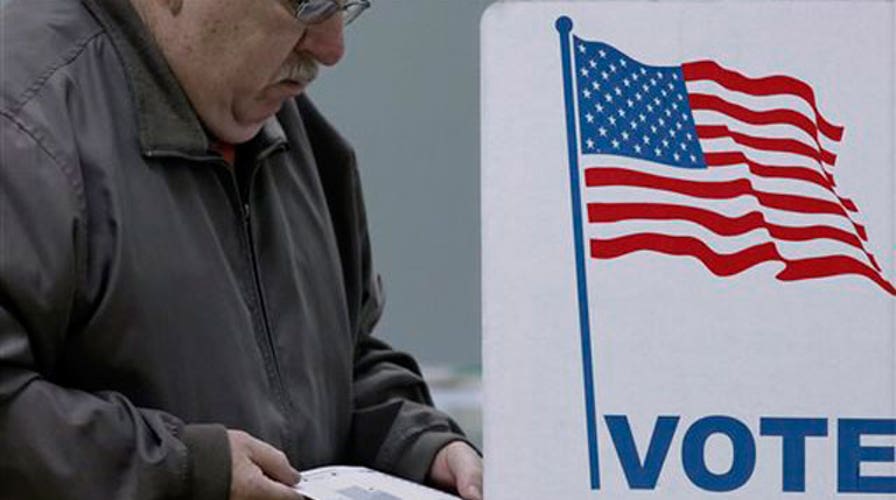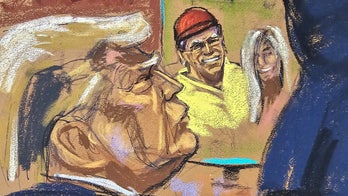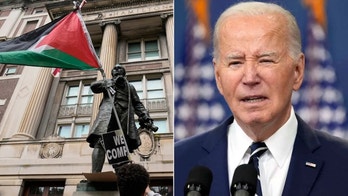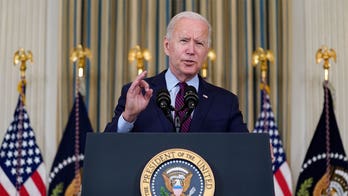Battle for Senate underway as Americans head to polls
Peter Doocy reports from Washington, D.C.
It’s in the voters’ hands now.
After two years of tireless campaigning by hundreds of congressional candidates – and thousands of candidates at the state level – Americans head to the polls on Tuesday to decide the balance of power in Congress and state capitals across the country.
Turnout is key for both parties, especially Democrats, as candidates battle historical midterm headwinds that typically punish whichever party holds the White House. Polling consistently has shown GOP voters are more enthusiastic about this year's elections, suggesting an edge in turnout -- but Democrats point to a tried-and-true ground game they claim will pull them through in the end.
"That makes a big difference in close races, and there are any number of close races," White House Press Secretary Josh Earnest said.
Indeed, voters might be hearing "too close to call" many times as they watch returns Tuesday night.
Voters will decide on 36 Senate and 435 House races, as well as another three-dozen gubernatorial races. But the overwhelming focus remains on a handful of tight Senate contests that will determine whether Republicans take total control of Capitol Hill.
To achieve that, Republicans need to retain control of the House (which is considered very likely) and net six seats in the upper chamber. Three races are more or less locked down for the GOP, barring a stunning upset: Montana, South Dakota and West Virginia.
But Republicans remain locked in competitive races in a number of other states, including those that President Obama lost in 2012 and where he continues to have low approval ratings. This includes Alaska, Arkansas, Louisiana and North Carolina.
Arkansas is increasingly seen as a likely flip to Republican hands, with GOP Rep. Tom Cotton expected by many analysts to defeat Democratic Sen. Mark Pryor.
“I think all people on both sides agree that one is slipping away,” Democratic strategist and Fox News contributor Joe Trippi predicted. “But never say never.”
Relying on the anti-Obama voter sentiment, Republicans also are trying to upset Democratic incumbents in Colorado and New Hampshire and win Iowa’s open Democratic seat while trying to hold onto their own seats in Georgia, Kansas and Kentucky.
“In every midterm, the White House party, in this case the Democrats, says the president is not on the ballot, but he is,” Republican strategist and Fox News contributor Karl Rove said Monday.
If there’s a Republican wave, a telling sign of it would be in North Carolina, where Republican challenger Thom Tillis has trailed Democratic Sen. Kay Hagan since June, or in New Hampshire, where GOP challenger Scott Brown has closed the lead on Democratic Sen. Jeanne Shaheen. If Republicans fare well there, it spells trouble for Democrats elsewhere.
But there’s a possibility America won’t even know the outcome on election night.
Late-tallied votes from rural Alaska and a likely runoff in Louisiana between Democratic Sen. Mary Landrieu and Republican challenger Rep. Bill Cassidy – and a possible runoff in the Georgia race, where a nominee must get 50 percent of the votes to win -- could keep control of the Senate undecided for days, or even until next year.
“So we’ve got Christmas and New Year’s where we can all be glued to the [TV] set to watch two people campaign across the state of Georgia,” Rove said.
Democrats, including Vice President Biden and Democratic National Committee Chairwoman Debbie Wasserman Schultz, disagree with most oddsmakers, predicting over the weekend that their party will keep control of the upper chamber.
“We’re going to hold the Senate,” Wasserman Schultz told ABC News.
On Monday, Earnest said Obama agrees with their assessments.
“It’s rooted in the idea that as voters home in on the central question in this campaign, which is: Are you going to be supportive of a candidate fighting for policies that benefit middle-class families? That is a very strong argument for Democrats to ... make,” he told reporters.
Republicans also are looking to add to their House majority.
Of the 435 races, 233 seats are held by Republicans and 199 held by Democrats. The other three races are for vacant seats.
Democrats would need 17 seats to take the majority, an unlikely possibility. Rather, Republicans are expected to pick up at least five more seats. Though House Democrats face the same headwinds as their Senate counterparts, modest gains are expected because most seats in GOP-leaning districts already are held by Republicans.
Among the most compelling races are ones in Arizona and New York.
In Arizona, Republican Martha McSally, the first female Air Force pilot to fly in combat, is trying again to take a House seat from Democrats. And in New York, 30-year-old Republican Elise Stefanik would be the youngest female House member if she wins Tuesday.
McSally is running in one of the few remaining moderate districts, for the seat once held by Democratic Rep. Gabrielle Giffords, who retired from Congress in 2012 after being shot in the head during a mass shooting.
McSally again faces Democratic Rep. Ron Barber, the former Giffords staffer who narrowly defeated McSally in 2012.
The nonpartisan RealClearPolitics.com lists the race as a tossup.
In New York, Stefanik, a former Bush White House aide, has positioned herself as a first-time candidate eager to bring “new ideas” and “new leadership” to the upstate 21st District.
She faces Democratic nominee and film producer Aaron Woolf and third-party candidate Matt Funiciello for the open seat of retiring Democratic Rep. Bill Owens.
The Harvard graduate, who also worked on the Romney 2012 campaign, holds an 18-point lead in the race, according to a recent WWNY-7 News/Siena College poll.
Nearly a dozen U.S. governors are considered in political peril on Election Day, making it one of the toughest years for incumbent governors in decades.
One survey, by Governing magazine, puts the number of toss-up races at 18 when including eight “competitive” races.
Louis Jacobson, who handicapped the races for Governing, pointed out Monday that the last time a large number of incumbents lost was 1990, when four were defeated. That number will likely be eclipsed on Tuesday, considering Hawaii Democratic Gov. Neil Abercrombie lost his primary race and Pennsylvania Republican Gov. Tom Corbett is widely expected to lose.
“So you only really need a couple more,” Jacobson said.
He argues the situation that governors face going into Tuesday is more of an anti-incumbent sentiment than the anti-White House feeling that looms over the Senate races.
“This is not limited to one party,” Jacobson said. “If the anti-incumbent wave is strong for Democrats, it would undercut Republicans’ likely Senate gains.”
The incumbents in Governing’s 10 tossup races are a mix of seven Republicans and three Democrats and include such high-profile state leaders as Florida GOP Gov. Rick Scott.
The others are Michigan Republican Rick Snyder, Georgia Republican Nathan Deal, Alaska Republican Sean Parnell, Wisconsin Republican Scott Walker, Kansas Republican Sam Brownback, Connecticut Democrat Dan Malloy, Illinois Democrat Pat Quinn and Maine Republican Paul LePage.
Scott has steadily closed the lead of front-running Democratic challenger Charlie Crist -- in one of the tightest and most expensive gubernatorial races in history.
Crist is a former Florida Republican governor who has twice changed political parties.
The $62.7 million spent so far on TV ads, according to a Center for Public Integrity media analysis, helps make it the most expensive gubernatorial race of the year.





